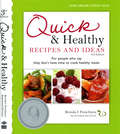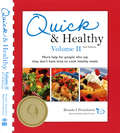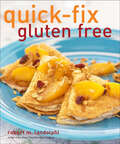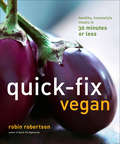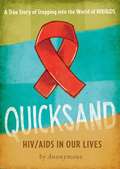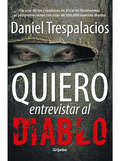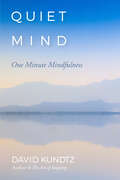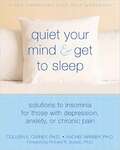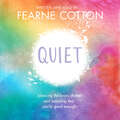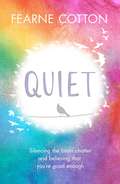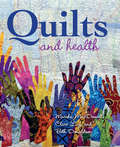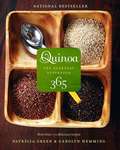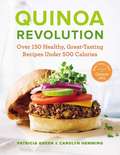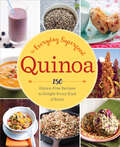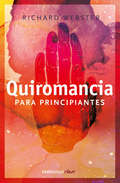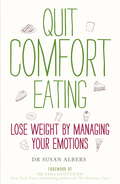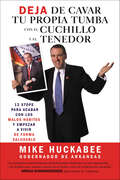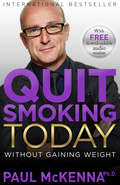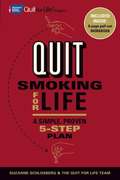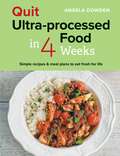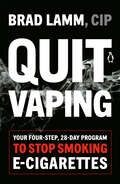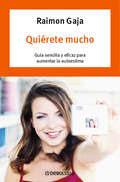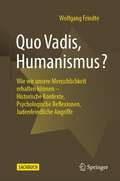- Table View
- List View
Quick and Healthy Recipes and Ideas
by Brenda PonichteraThe third edition edition of this bestseller is now published by Small Steps Press! People spend less time cooking than ever before-but where do they turn when they still want to eat healthy? Quick & Healthy brings you over 200 easy recipes that are low in fat, cholesterol, and calories-and take almost no time to prepare. With recipes designed for the busy cook, this latest edition includes practical nutrition information as well as quick, delicious recipes that have been kitchen-tested for taste and ease. Inside, you will find time-saving ideas, tips to reduce fat and cholesterol, and even food exchanges for weight loss and diabetes.
Quick and Healthy Volume II
by Brenda PonichteraOver 750,000 copies of Quick and Healthy Vols. I and II soldThis second edition of this best-seller includes ten weeks of easy low-fat dinner menus, each with a grocery list AND over 100 menus listed by category. Designed for busy people with lots of good intentions and little time to cook, Volume II also offers over 200 easy, low-fat recipes and lots of tips to make healthy eating easier than ever. It includes practical nutrition information to improve your health, including tips to reduce fat, guidelines for changing recipes, tips for eating out and holiday guidelines; a worksheet for determining ideal weight, calorie needs and recommended fat grams; recipes listed by grams of carbohydrate; food exchanges for weight loss and diabetes; and much more! It's also perfect for anyone wanting to lose weight or anyone with heart disease or diabetes. Quick And Healthy Volume II and its companion, Quick And Healthy Recipes and Ideas, are both Benjamin Franklin Award winners and are two cookbooks dietitians and physicians are recommending to all their patients."My patients love cooking with this cookbook! Quick And Healthy Volume II is a great addition to any kitchen!"-Georgia Kostas, MPH, RD, Nutrition Director, Cooper Clinic, Dallas, TX.My favorite cookbooks focused on healthy, quick recipes include the Quick And Healthy series by Brenda J. Ponichtera.-David L. Katz, MD, director of Yale-Griffin Prevention Research Center, medical consultant for ABC News, and columnist for O, The Oprah Magazine.
Quick-Fix Gluten Free (Quick-Fix Cooking #3)
by Robert M. LandolphiEnjoy delicious gluten-free recipes all day long with these 100 quick & easy recipes created by a professional chef and gluten-free expert.Gluten-free professional chef Robert M. Landolphi proves that a gluten-free lifestyle doesn’t have to be bland and boring, labor-intensive, or time consuming inside Quick-Fix Gluten Free. In preparation for his follow-up to Gluten Free Every Day Cookbook, Landolphi queried fans about their biggest gluten-free challenges and created Quick-Fix Gluten Free in response to the dishes.Divided into nine sections delving into everything from appetizers and breakfast to hearty, internationally inspired dishes, fan favorite comfort foods and decadent sweets and treats, Quick-Fix Gluten Free offers 100 fast and easily prepared recipes for crave-worthy dishes like Cinnamon Dusted French Toast, Kickin’ Paella, Gnocchi with Roasted Garlic Butter and Parmesan Cheese, and Aunt Lil’s Rich and Creamy Cheesecake. With a focus on fast, fresh and flavorful, these contemporary dishes are simple enough for everyday meals and delicious enough to serve to anyone–whether they are on a gluten-free diet or not.Whether your choice to live gluten free is driven by the desire to lose weight, comply with a celiac diet, the need to avoid wheat because of mild allergies or the suspected link between gluten and autism, Quick-Fix Gluten Free proves that once-taboo foods like crusty breads, creamy pastas and indulgent cakes are no longer off-limits.
Quick-Fix Vegan: Healthy, Homestyle Meals in 30 Minutes or Less (Quick-Fix Cooking #4)
by Robin RobertsonThe acclaimed author of Quick-Fix Vegetarian shares 150 easy and delicious vegan recipes—plus helpful tips for your vegan kitchen and pantry.Robin Robertson’s Quick-Fix Vegan features everything from starters, snacks, salads, sauces, and sandwiches to stovetop suppers, pastas, soups, and desserts that can all be prepared in 30 minutes or less. It also includes “Make-Ahead Bakes,” convenient recipes that are assembled ahead of time (in less than 30 minutes) and then baked before serving.Quick-Fix Vegan draws upon a myriad of ethnic influences such as French, Mexican, Cajun, Middle Eastern, and more. Recipes include Spicy Black Bean Hummus with Orange, Korean Hotpot, Rotini with Creamy Avocado-Herb Sauce, Moroccan-Spiced Pumpkin Soup, BBQ Pinto-Portobello Sandwiches, Burmese Ginger Salad, Autumn Harvest Gratin, and Catalan-Style Creme Brulee.Robertson also shares secrets on maintaining a “quick-fix” vegan kitchen, including pantry suggestions and kitchen tips, as well as basic recipes for ingredients such as homemade vegetable stock and seitan.
Quicksand: HIV/AIDS in Our Lives
by Anonymous<P>What is it like to be affected by HIV/AIDS? <P>A moving first-person account offers insight- and basic facts. <P>One day I found out that someone I know- my brother-in-law, Jay- had HIV/AIDS. <P>At the moment I heard his diagnosis, I realized that I had stepped into the quicksand of a new and terrible world -- and I was sinking fast. <P>Weaving together her own story with straightforward questions and answers, the author explains the real ways that HIV/AIDS can be transmitted and explores the common experiences and emotions that might be encountered by friends and family members of someone who has the virus. <P>She also discusses why HIV/AIDS is often still kept a secret and the importance of treating this condition like any other. <P>With up-to-date medical information that has been thoroughly vetted by experts, this first-person narrative offers an invaluable look at what it is like to watch someone you know battle HIV/AIDS.
Quiero entrevistar al diablo
by Daniel TrespalaciosDe uno de los creadores de El Cartel Paranormal, el programa radial conmás de 500.000 oyentes diarios Los fenómenos paranormales ocurren todos los días, ¿pero qué tan reales son? Descubrirlo ha sido la obsesión de Daniel Trespalacios, periodista y uno de los creadores del exitoso programa radial El Cartel. En este libro narra, por primera vez, las experiencias más aterradoras que ha vivido en los últimos doce años, desde el encuentro con fantasmas, hasta la visita a lugares abandonados a los que nadie se ha atrevido a entrar, presenciar un exorcismo y entrevistar a un hombre que decía ser un vampiro. Luego de experimentar lo paranormal en carne propia, Trespalacios no le teme a nada, ni siquiera a la posibilidad de entrevistar al diablo
Quiet Mind: One Minute Mindfulness
by David KundtzDaily Mindful Minutes are Necessary for StillnessDavid Kundtz offers readers mindful minutes through the power of stillness. In the haste of everyday life, Quiet Mind offers us an extension of time by allotting us moments of healing and self introspection. Find yourself in the spaces between yourself and life. The miracle of mindfulness is a welcome respite for anyone who lives a life that feels nonstop. Connect with your inner self by pausing your thoughts, banishing your self-doubt, and embracing a daily practice of observing a moment of silence. Welcome yourself to a quiet mind. Quiet Mind is an invitation to rest, find peace, awaken, and remember. You will find guidance on using the moments between activities, which the author calls “still points,” as opportunities to focus on becoming more fully awake to who you are at any time, even during one, sacred mindful minute.Inside this mindful moment book, you’ll find:Ways to cultivate a positive mindset to remain open to infinite possibilities of spiritual growthA series of reflections that can assist you with unwinding anxiety blocking your path to spiritual connectionInsight that stems from spirituality and the psychology of introspection If you like how to “be mindful” books like Return to You, Breath, or Each Day a Renewed Beginning, you’ll love Quiet Mind.
Quiet Your Mind And Get To Sleep: Solutions To Insomnia For Those With Depression, Anxiety Or Chronic Pain
by Colleen E. Carney Rachel Manber Richard BootzinA busy and hectic life can profoundly affect your ability to get a good night's rest. And it's even more difficult to feel relaxed when you stay awake worrying that you won't fall asleep. This vicious circle can quickly rob you of your quality of life, which is why it is so important to seek the most effective treatment for your insomnia. This workbook uses cognitive behavior therapy, which has been shown to work as well as sleep medications and produce longer-lasting effects. Research shows that it also works well for those whose insomnia is experienced in the context of anxiety, depression, and chronic pain. The complete program in Quiet Your Mind and Get to Sleep goes to the root of your insomnia and offers the same techniques used by experienced sleep specialists. You'll learn how to optimize your sleep pattern using methods to calm your mind and help you identify sleep-thieving behaviors that contribute to insomnia. Don't go without rest any longer-get started on this program and end your struggles with sleep.
Quiet: Silencing the brain chatter and believing that you're good enough
by Fearne Cotton'Fearne Cotton and Frankie Bridge have encouraged fans to open up about their mental health issues in inspirational social media posts' Hello.comIn Quiet, Fearne Cotton explores why so many of us question whether we are, or will ever be, 'good enough.' This beautiful book, filled with Fearne's creative hand-drawn illustrations and thought-provoking activities to still your mind, will silence your inner-critic and stop you from continually self-sabotaging.Quiet includes interviews with people who have helped Fearne to accept her flaws and love her own imperfections, as well as advice on how to drown out misinformation and the, sometimes, pressurising noise from family, work and friends, which can fuel our insecruties and self-doubt.Fearne talks honestly and openly about what it's like to live in the public eye and shares some of the methods and practical activities she uses to ignore negative online chatter and trolls. She acknowledges the terrifying stats and research linking social media to rising levels of depression, anxiety and other mental health issues in young people and offers advice about how to listen more selectively to what we are told in an era of constant-sharing, over-sharing nand general misinformation about what is 'good' or 'bad' for us. Stop competing with all the noise out there and accept that Quiet might be your most formidable force yet.Written and Read by Fearne Cotton(P) Orion Publishing Group 2018
Quiet: Silencing the brain chatter and believing that you’re good enough
by Fearne Cotton'Fearne Cotton and Frankie Bridge have encouraged fans to open up about their mental health issues in inspirational social media posts' Hello.comThis book is about taming the bad inner voice - the one that has the power to overthrow gut instinct and talk us out of new adventures. We are all brimming with inner wisdom, yet we allow negative thoughts to confuse us. We forget how capable and strong we can be. There is confidence there even if it's hidden; there is courage, beauty, wisdom and belief - we just need some quiet to notice it.Love, Fearne xxx-From Sunday Times bestselling author Fearne Cotton, this is the handbook for modern life we all need. Including expert advice, ideas to put into practice, adventures to complete and interviews with everyone from Bryony Gordon to Billie Piper, Quiet seeks out ways to help you tune out the negative backchat that holds you back, so you can hear the positives that will guide you forwards . . .PRAISE FOR FEARNE HAPPYFearne's account is wonderfully honest and relatable, and it's also extremely comforting and reassuring too - knowing that even someone in her position is still working through certain issues - issues that a lot of us are working through too. (MIND)Fearne Cotton's new book is full of useful advice on how to live a happier life. (Viv Groskop THE POOL)I recommend this for anyone who's looking to find true consistent happiness (Craig David)She's known for her fun and upbeat presenting style, but Fearne Cotton has also been bravely open about her struggle with depression during some darker points in her life. . . In our busy 2017 lives that are constantly fuelled by Instagram envy, bad Tinder dates and increasingly outrageous politicians, it's nice to go over the basics of simply being happy. (OK!)
Quilts and Health
by Marsha MacDowell Clare Luz Beth DonaldsonName an illness, medical condition, or disease and you will find quiltmaking associated with it. From Alzheimer’s to Irritable Bowel Syndrome, Lou Gehrig's Disease to Crigler-Najjar Syndrome, and for nearly every form of cancer, millions of quilts have been made in support of personal well-being, health education, patient advocacy, memorialization of victims, and fundraising. In Quilts and Health, Marsha MacDowell, Clare Luz, and Beth Donaldson explore the long historical connection between textiles and health and its continued and ever growing importance in contemporary society. This lavishly illustrated book brings together hundreds of health-related quilts—with imagery from abstract patterns to depictions of fibromyalgia to an ovarian cancer diary—and the stories behind the art, as told by makers, recipients, healthcare professionals, and many others. This incredible book speaks to the healing power of quilts and quiltmaking and to the deep connections between art and health.
Quinoa 365: The Everyday Superfood
by Patricia Green Carolyn HemmingOne of the world's healthiest foods, quinoa contains a perfect balance of all eight essential amino acids, and is a great source of protein, making it an increasingly popular food choice for those looking to incorporate 'superfoods' into their everyday diets. Gluten-free, wheat-free, and nutrient-packed, quinoa is ideal for those who are health-conscious, vegetarian, and/or physically active, as well as for those with gluten intolerance, wheat allergies, and other digestive disorders. But that's not all: You can eat quinoa guiltlessly knowing it's free of cholesterol and trans fats.
Quinoa Revolution: Over 150 Healthy, Great-tasting Recipes Under 500 Calories
by Patricia Green Carolyn Hemming Nicole WinstanleyBestselling authors Patricia Green and Carolyn Hemming show how the ancient superfood quinoa is revolutionizing the lives of people everywhere, addressing numerous health and lifestyle concerns such as weight loss, vegetarian diets, food allergies, gluten intolerance, heart conditions, and more. Quinoa Revolution demonstrates the extreme versatility of quinoa and how to increase your nutrition and revamp what you're eating now-with recipes that are great tasting and healthy. In addition to being one of the world's healthiest foods, quinoa's long list of amazing properties is what makes it so versatile in any number of recipes. Quinoa Revolution reveals how quinoa is not only used to boost nutrition, but how it can be used for any of its unique characteristics, including to enhance taste or texture, to thicken, hold moisture, replace gluten, increase protein, and more. Quinoa offers more than just salads. In everything from light snacks to full meals and even dessert, this nutrient-superior superfood plays a role. Healthful recipes include 'Chipotle Corn Chowder,' 'Red Velvet Waffles,' 'Korean Barbeque Beef Wraps,' 'Black Forest Goat Cheese Brownies,' 'Ginger Peach Crisp,' and more.
Quinoa: 150 Gluten-Free Recipes to Delight Every Kind of Eater
by Sonoma PressDiscover the power of quinoa!In recent years, quinoa has gained a place in America's pantries because of its versatility and amazing health benefits. The ancient grain—which is really a seed—is gluten-free, a protein powerhouse, and rich in many other nutrients, making it a perfect substitute for wheat and other grains. But incorporating a new food into your diet can take some inspiration and guidance.With Quinoa: The Everyday Superfood, a collection of over 150 simple, out-of-the-box recipes featuring the delicious super grain, you'll learn how to use quinoa beyond a basic salad or side. From satisfying breakfasts like Almond and Coconut Quinoa Porridge, to delicious snacks like Cauliflower Quinoa Fritters, to creative entrees like Black Bean and Quinoa Veggie Burgers, Quinoa: The Everyday Superfood will teach you how to incorporate this enticing ingredient into satisfying everyday meals that will boost your nutrition and revamp the way you eat. Our book offers:150 RecipesIcons indicating vegetarian, vegan, dairy-free (highlighting the types of eaters that make up "everyone")Simple ingredientsOut-of-the-box yet accessible recipes (more than just salads and sides, this book teaches you how to use quinoa to its full potential)4-color photos throughout
Quints: The Cleanup
by Leslie McguireThe Quints are five adorable, identical little babies born to loving families everywhere. Join each special set of Quints in their "Adventures for 5" and see what happens when every little thing they do is 1, 2, 3, 4, 5 times the fun!
Quiromancia para principiantes
by Richard WebsterCon viñetas, ejemplos prácticos y guías para hacer una lectura completa, Quiromancia para principiantes tiene todo lo necesario para que te conviertas en el quiromántico que siempre deseaste ser.El especialistas en metafísica y temas psíquicos, Richard Webster, ofrece su experiencia de más de cuarenta años para ayudarte a descubrir este arte milenario.La quiromancia es mucho más que leer la palma de la mano y adivinar el futuro de una persona: las manos de alguien -sus dedos, su palma, su textura, sus marcas- te hablan de su pasado, de su presente y de su futuro, así como de su forma de pensar, sus virtudes, debilidades, miedos y deseos.En Quiromancia para principiantes aprenderás:- Qué nos pueden decir las líneas de la mano sobre el amor, el destino, la salud y la felicidad.- Qué dicen de tu personalidad la longitud y la forma de tus dedos.- Cómo los patrones que forman las líneas en tu palma pueden darte un sentido del humor extraordinario, un asombroso talento musical o una memoria insólita.- Cómo contestar a las preguntas más frecuentes que los quirománticos reciben: "¿Tendré salud?", "¿Seré rico?", "¿Me enamoraré?", "¿Seré feliz?".
Quit Comfort Eating: Lose weight by managing your emotions
by Dr Susan Albers PsyDWhy can't so many smart people lose weight? The answer: low emotional intelligence can lock you into a vicious cycle of dieting failure. Dr Susan Albers, accomplished expert in emotional eating and weight loss, has created an accessible three-step plan that will teach you how to combat the most common emotional barriers to weight loss. Her EAT plan tackles comfort eating, the pressure of social eating so common in offices, stress-triggered eating, eating to avoid emotional problems and using food to numb trauma.Drawing on mindfulness, Dr Albers provides 25 tools and techniques readers can use to tailor their eating to the demands of their own lives, their preferences and moods. Reverse a lifetime of overeating and comfort bingeing with Quit Comfort Eating.
Quit Digging Your Grave with a Knife and Fork: A 12-Stop Program to End Bad Habits and Begin a Healthy Lifestyle
by Mike HuckabeeNow available in Spanish, the bestselling book in which a leaner Arkansas Governor Mike Huckabee shares his secrets for creating better health habits that last a lifetime.
Quit Smoking Today Without Gaining Weight
by Paul McKennaAre you worried about how smoking is damaging your health?Do you want to quit smoking, but worry that you’ll gain weight?Would you like to stop cravings in a matter of moments?Have you tried to quit before, only to start again?If quitting was easy, would you do it today?THEN LET PAUL McKENNA HELP YOU!Over the past three decades, Paul McKenna, Ph.D., has developed a unique approach that makes quitting surprisingly easy. Through the simple conditioning techniques revealed in this book and downloadable hypnosis session, you can retrain your mind and body so you no longer need cigarettes and actually feel better without them. Better still, you are highly unlikely to gain weight in the process! It doesn’t matter if you’ve smoked all your life, if you’ve tried to quit many times before, or if you don’t believe this system will work for you. All you have to do is follow Dr. McKenna’s instructions fully and completely and he can help you to feel free of cigarettes.
Quit Smoking for Life: A Simple, Proven 5-Step Plan
by Suzanne SchlosbergBased on the techniques used in the nation's leading evidence-based tobacco cessation program, Quit Smoking for Life leads readers through a simple, proven method to quit smoking and remain tobacco-free for life.<P><P> It's full of engaging real stories from ex-smokers and experienced quitting coaches and includes a pull-out quitting plan and workbook.
Quit Ultra-processed Food in 4 Weeks: Simple recipes & meal plans to eat fresh for life
by Angela DowdenBreak free from ultra-processed foods with this practical guide Have you ever wondered why you can't stop reaching for chocolates, ice cream, fizzy drinks, and snacks? All of these familiar suspects are ultra-processed foods: they're filled with additives and preservatives to keep you coming back for more. So how do you avoid ultra-processed foods when they're everywhere around you? This book will help you through every step of the way: you'll learn to check food label checklists and stock up your cupboard with healthy foods. With over 100 recipes for every meal, plus four weekly meal plans and shopping lists, you can easily eat unprocessed food on the go.CONTENTS INCLUDE:BreakfastsMaple-glazed granola with fruit; Wholemeal cheese & bacon muffins; Moroccan-inspired baked eggsLunchesButter bean, tomato & feta salad; Vietnamese-style noodle salad; Roasted chickpeas with spinachDinnersChargrilled halloumi with olives; Frying pan macaroni cheese; Mediterranean roast lambDessertsHoney ricotta fritters with pistachios; Blackberry & apple crumbles; Chocolate puddle puddingBakingPeach & brown sugar muffins; Mixed-seed soda bread; Chocolate flapjacksSnacks & DrinksPopcorn with chilli oil; Fresh lemonade; Orange & passionfruit sparkler
Quit Ultra-processed Food in 4 Weeks: Simple recipes & meal plans to eat fresh for life
by Angela DowdenBreak free from ultra-processed foods with this practical guide Have you ever wondered why you can't stop reaching for chocolates, ice cream, fizzy drinks, and snacks? All of these familiar suspects are ultra-processed foods: they're filled with additives and preservatives to keep you coming back for more. So how do you avoid ultra-processed foods when they're everywhere around you? This book will help you through every step of the way: you'll learn to check food label checklists and stock up your cupboard with healthy foods. With over 100 recipes for every meal, plus four weekly meal plans and shopping lists, you can easily eat unprocessed food on the go.CONTENTS INCLUDE:BreakfastsMaple-glazed granola with fruit; Wholemeal cheese & bacon muffins; Moroccan-inspired baked eggsLunchesButter bean, tomato & feta salad; Vietnamese-style noodle salad; Roasted chickpeas with spinachDinnersChargrilled halloumi with olives; Frying pan macaroni cheese; Mediterranean roast lambDessertsHoney ricotta fritters with pistachios; Blackberry & apple crumbles; Chocolate puddle puddingBakingPeach & brown sugar muffins; Mixed-seed soda bread; Chocolate flapjacksSnacks & DrinksPopcorn with chilli oil; Fresh lemonade; Orange & passionfruit sparkler
Quit Vaping: Your Four-Step, 28-Day Program to Stop Smoking E-Cigarettes
by Brad LammThe first-ever book on how to quit vaping will help you stop for good and improve your lung health.Vaping has become an urgent public health crisis. Almost 15 million Americans not only are consuming concentrations of nicotine more potent and addictive than traditional cigarettes, but they also are inhaling deadly carcinogens such as formaldehyde, benzene, and propylene glycol, an ingredient in anti-freeze. Vapers are dying, health professionals are sounding the alarm, and parents are struggling to help their addicted teenagers.Certified interventionist Brad Lamm debunks the myths spread by the thriving e-cigarette industry and its supporters, revealing the truth about the effects of inhaling these highly dangerous aerosols. Then he offers a step-by-step blueprint to break free of its grip. This simple, 28-day program provides specific actions to take, day by day, as you free yourself from nicotine addiction. Key information and special considerations throughout help and guide parents of young vapers through the process as well. Learn how to create a quit plan, build a support team, follow a detox, change your inner dialogue, manage your cravings, and become a non-vaper. The plan offers a rich variety of strategies, tactics, hacks, exercises, research, and inspiring stories of people who have quit the habit using Lamm's proven program.A PENGUIN LIFE TITLE
Quiérete mucho
by Raimon GajaA menudo mantenemos actitudes negativas y generamos pensamientos llenos de desespero que nos desmotivan, nos impiden alcanzar nuestros objetivos y nos hacen sentir desgraciados o culpables. Una baja autoestima impide llevar una vida psicológicamente saludable. Partiendo de la premisa que entender la causa de este problema es el punto de partida para empezar a solucionarlo, Quiérete mucho nos muestra caminos alternativos que nos ayudan a cambiar este patrón negativo y desprendernos de los obstáculos que nos impiden desarrollar todo nuestro potencial. Raimon Gaja trata el tema de la autoestima con el rigor y la importancia que se merece, sin reducirla aun simple aspecto secundario. A través de varios cuestionarios, Quiérete mucho nos da claves para evaluar nuestro nivel de autoestima y saber qué tipo de pensamiento distorsionado tenemos. Estos cuestionarios se repiten para ir comprobando nuestras evoluciones.
Quo Vadis, Humanismus?: Wie wir unsere Menschlichkeit erhalten können - Historische Kontexte, Psychologische Reflexionen, Judenfeindliche Angriffe
by Wolfgang FrindteWie steht es mit den humanistischen Grundlagen unseres Lebens und Zusammenlebens? Müssen wir uns nicht gerade heute dieser Fundamente versichern? Wer greift diese Fundamente an? Um diese Fragen beantworten zu können, nutzt der Autor ein Konstruktionsprinzip, mit dem die humanistischen Anstrengungen seit Petrarca in dreifacher Weise gerahmt werden: Zum einen werden diese Anstrengungen in die jeweiligen historischen Kontexte eingeordnet; zum zweiten greift er auf Reflexionen zurück, die sich in den verschiedenen Entwicklungsetappen der Psychologie explizit oder implizit auf den Humanismus beziehen; drittens schließlich macht er auf judenfeindliche und antisemitische Äußerungen, Vorurteile, Diskriminierungen und Vernichtungsexzesse aufmerksam, um die Ambivalenzen der verschiedenen humanistischen Anstrengungen zu verdeutlichen. Denn, so der Autor, die Einstellung und das Verhalten gegenüber Jüdinnen und Juden sind der Lackmustest eines jeglichen Humanismus.
